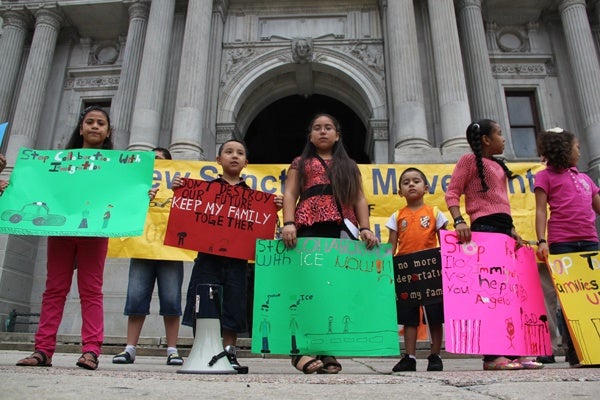Pa. immigrants apprehensive about latest ICE sweep
Listen
Children of undocumented immigrants rally at City Hall in August 2013. (Emma Lee/for NewsWorks)
In January, Immigration and Customs Enforcement agents picked up 121 women and children from Central America across the country in just three days.
Last week, U.S. immigration officials launched the latest in a series of deportation efforts, again targeting Central American families who came to the United States after 2013.
With each sweep, immigrant communities in Pennsylvania and elsewhere wonder how many people will be sent back this time — and if the narrow focus on Central American families will continue.
“We didn’t see like a big sweep, what people might typically think of like a large raid in Philadelphia,” said Peter Pedemonti, executive director of faith-based immigration advocacy group the New Sanctuary Movement. “What we have seen is them still targeting Central American families and going to individual houses.”
During that surge, the largest clusters of those rounded up for deportation were in Georgia, Texas and North Carolina.
ICE does not discuss current operations, but spokeswoman Jenn Elzea confirmed that the recent surge is part of recurring efforts to crack down on certain groups, including unaccompanied children and criminals.
“As we have stated repeatedly, the Department of Homeland Security must enforce the law consistent with our enforcement priorities,” said Elzea in a statement. “To promote and protect border security, our priorities include those apprehended crossing the border illegally after Jan. 1, 2014. This includes single adults, as well as adults who bring their children with them.”
The federal government makes an effort not to apprehend people in “sensitive locations such as schools, hospitals and places of worship,” she said. Those targeted have exhausted all legal recourse to stay in the country.
Of the 121 people picked up in January, about 78 have been deported. The rest have pending claims in immigration court.
With ICE surges coinciding and paralleling regular deportation operations, each new wave pricks paranoia in local immigration communities.
“What they say is that they are going to focus on mothers and children that enter in 2014, but the reality is they come, knock the doors and take anybody they find there,” said Estela Hernandez, a mother of three from Mexico living in the area without legal status.
When the last push to deport Central American families was announced in January, she said, some families went into hiding, even if they were not part of the group targeted.
“Many people, they didn’t take their children to school, they stopped living their life normally” out of fear, she said. That sentiment was echoed by various immigration rights groups, which said they received dozens of calls from concerned immigrants.
At that time, area immigration advocacy groups — such as the New Sanctuary Movement, JUNTOS and PICC — held trainings on how to respond if federal agents arrived at your house. This time, said Pedemonti, they want to step up their advocacy.
“It has to be something more than ‘know your rights’ trainings,” he said.
Elzea would not confirm the time frame for the most recent surge, but other news outlets have reported it will continue into June.
WHYY is your source for fact-based, in-depth journalism and information. As a nonprofit organization, we rely on financial support from readers like you. Please give today.

